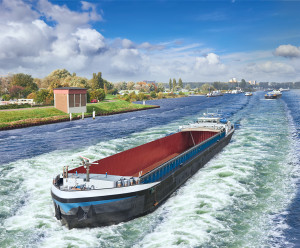Many factors favour inland waterway transport in Sweden. It offers relief to the heavily burdened Swedish road system. Its reliability (“just-in-time”) is high. The gains it offers in terms of sustainability and the environment are major. Moreover, several recent projects point to major socio-economic benefits. Still, it has taken a while for inland waterway transport – often call the fifth mode of transport – to get the wind in its sails. But now things might be turning around.
One important breakthrough came in December 2014, when Sweden incorporated EU Directive 2006/87 into Swedish law. But there are still no complete statistics on goods shipments via Sweden’s inland waterways. According to Regulation EC 1365/2006, it is time for such statistics to be compiled in Sweden. The Swedish authority Transport Analysis has been tasked with managing the gathering of such statistics, using 2016 as the reference year. Statistics will be gathered for 20 ports. Other protected waters may have potential for inland waterway transport in the future. This pertains to shipping goods within Swedish archipelagos and in harbours and project harbours in connection with, for example, road building.
Soil, rock, gravel, clay, and sand dominate
When it comes to the types of goods transported, there is data available from 2014. Soil, rock, gravel, clay, and sand dominated, with just over 400,000 tonnes of such goods transported on Sweden’s inland waterways. These goods were followed by petroleum products at nearly 43,000 tonnes, grain at just over 27,000 tonnes, and cement, lime, and other construction materials at just over 7000 tonnes.
Relocating fuel depots could be an unexpected success
A trailblazing project concerning urban logistics and inland waterway transport is currently underway. Joakim Swahn of the analysis firm M4Traffic reported on the project at Transportforum, and audience interest was strong. The project concerns fuel distribution via Lake Mälaren waterways and, if it goes well and is completed, could offer another positive breakthrough for the fifth mode of transport.
M4Traffic has been tasked with the research project by Swedish Maritime Administration and the Swedish Transport Administration. The project has its roots in a desire to close the major fuel depots in Berg in Nacka and Loudden in Stockholm. Those depots currently supply most of Stockholm County with fuel, but the land they occupy is needed for building and densifying the city. As a result, relocating the depots to Södertälje is on the drawing board. However, such relocation could entail a significant increase in the number of lorry shipments in the region. The alternative studied in the project involves replacing some lorry shipments with shipments by water. It is primarily lorry shipments to Stockholm’s northern suburban municipalities that are targeted for replacement with shipments via the region’s inland waterways.
Facts: inland waterway transport
- Comprises traffic on inland waterways (i.e., rivers, lakes, canals, and coastal routes) where the maximum wave height over time is two metres
- Is subject to EU regulations incorporated into Swedish law in December 2014
- Europe has a highly developed and established system comprising 40,000 km of congestion-free waterways, which carry up to 44% of the shipping in the areas surrounding major European ports.
- At issue are local traffic, regional traffic, and urban logistics within cities and regions as well as between ports. In Sweden, this pertains to Lake Mälaren, Lake Vänern, and along the coast.
- Supplements the transport system and relieves land-based infrastructure, competing primarily with shipment by lorry.
This article is a report from the VTI conference Transportforum 2016. You find more information about the conference here (in Swedish).







Follow us: